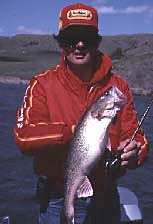|
|

|
 |
 | ||
Fishing Summertime Weeds
The deep water edges of weeds are the easiest to find and fish, however, donít ignore the inside edge which can hold fish much of the year. The security that weeds provide is important. Baitfish have concealment and escape from enemies. The weeds give off oxygen which allows fish to remain hidden in the weeds throughout most of the summer. Once you determine where the concentrations of baitfish are, bigger fish will be in the same area waiting to ambush their prey. Most fishermen donít know where to begin when they see an endless jungle of lilly pads, grass, hydrilla, coontail or cabbage. But, itís important to learn to fish these areas because depending on the region of the country you are fishing, these areas hold panfish, bass, pike, muskie and walleye, especially those weed beds adjacent to deep water. Begin by fishing the weed edges, both inside and out, and any weed pockets. Keep moving until fish are found, then slow down and concentrate in these "fishy" areas. You'll want to use a medium-heavy action spinning or casting rod. Your line should be matched to the rod, usually 10 to 20 pound test. Use a weedless spoon, a spinnerbait, or a weedless worm or jig. If using a sinker, use one just heavy enough to make casting easy. Peg your sinker to the worm head with a toothpick by sliding the toothpick into the sinker and breaking it off flush. This will keep the sinker against the worm allowing the bait to fall naturally into the pockets between the weeds. If you like to fish surface lures, you can twitch them in pockets and along the weed edges. This tactic works best in the earlier part of the season when weeds haven't quite reached the surface and lie a foot or so below the surface. Other surface lures also work. Use lures that when retrieved at a slow pace will sputter and make a fuss. Spinnerbaits or buzz baits are good choices. Dropped into pockets, the blades spin as they fall. Ripped through weeds, the imitate a fleeing fish. In-line spinners are still popular among weed anglers. Northern pike and muskie anglers have used these to take good numbers of these fish from in and around weeds. Now similar versions with single hooks can be cast into the midst of the thick stuff. When fishing weeds, cover as much water as possible. Pay particular attention to any changes in weed depth, or changes in the direction of the weedline. Also look for thicker than usual weed patches. These irregularities could mean a change in bottom substrate or other bottom feature that could hold fish. Fish as deep as possible, especially on bright days. Since most of your fishing will be done in fifteen feet of water or less, fish will often bust a top water lure with enthusiasm. When fishing pockets of weeds such as a natural opening, or a boat channel, or an opening into a spring or creek, let a spinnerbait, worm or jig free fall, then work it back after it hits the bottom. Oftentimes a fish will attack the lure just as it leaves the edge of the weeds. Be sure to continue fishing even after the lure appears to leave the tall weeds. In most cases, the weeds will continue out into deeper water, but may not be visible. Always be sure to move out to the edge and try casting a crankbait parallel to the weeds. This can be extremely effective especially on walleye, as they move into weedy areas to feed at dusk. And, when working weed beds near deep water, donít forget to turn around and cast to the dropoff with a bottom-bumping lure or jig. Tips for fishing the weeds:

Green weeds are extremely effective spots to fish during the summer months. They give off oxygen, and provide shade and cover that holds fish. Learning to master weed fishing techniques will pay off in catches of big fish.
|
|
|
| Site design by Outdoor Management Network Inc. Copyright © 1996 - 2007 Outdoor Management Network Inc. America Outdoors® is a registered trademark of Outdoor Management Network Inc. |
 Summertime fishermen will encounter weed growths in just about every body of water they fish. Weeds provides cover for baitfish, and food, security and hunting grounds for larger fish. Therefore, it is wise to learn as much as possible about fishing weed bed areas.
Summertime fishermen will encounter weed growths in just about every body of water they fish. Weeds provides cover for baitfish, and food, security and hunting grounds for larger fish. Therefore, it is wise to learn as much as possible about fishing weed bed areas.